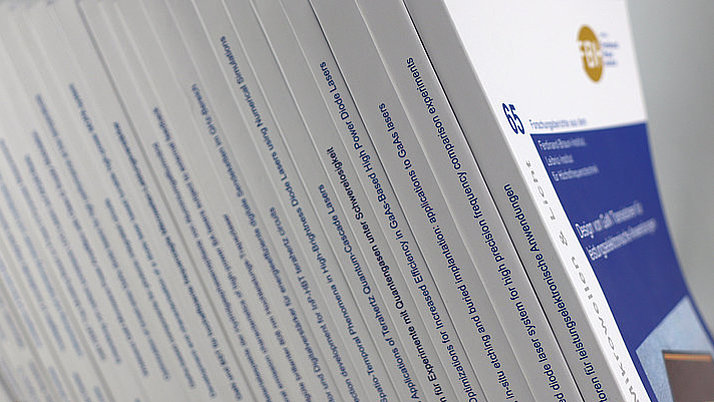60% Efficient Monolithically Wavelength-Stabilized 970-nm DBR Broad-Area Lasers
P. Crump, Md. J. Miah, M. Wilkens, J. Fricke, H. Wenzel, and A. Knigge
Published in:
IEEE Photonics J., vol. 14, no. 3, art. 1524305, doi:10.1109/JPHOT.2022.3166591 (2022).
Abstract:
Progress in epitaxial design is shown to enable increased optical output power Popt and power conversion efficiency ηE and decreased lateral far-field divergence angle in GaAs-based distributed Bragg reflector (DBR) broad-area (BA) diode lasers. We show that the wavelength-locked power can be significantly increased (saturation at high bias current is mitigated) by migrating from an asymmetric large optical cavity (ASLOC) based laser structure to a highly asymmetric (extreme-triple-asymmetric (ETAS)) layer design. For wavelength-stabilization, 7th order, monolithic DBRs are etched on the surface of fully grown epitaxial layer structures. The investigated ETAS reference Fabry-Pérot (FP) BA lasers without DBRs and with 200 µm stripe width and 4 mm cavity length provide Popt = 29 W (still increasing) at 30 A in continuous-wave mode at room temperature, in contrast to the maximum Popt = 24 W (limited by strong power saturation) of baseline ASLOC lasers. The reference ETAS FP lasers also deliver over 10% higher ηE at Popt = 24 W. On the other hand, in comparison to the wavelength-stabilized ASLOC DBR lasers, ETAS DBR lasers show a peak power increment from 14 W to 22 W, and an efficiency increment from 46% to 60% at Popt = 14 W. A narrow spectral width (< 1 nm at 95% power content) is maintained across a very wide operating range. Consistent with earlier studies, a narrower far-field divergence angle and consequently an improved beam-parameter product is also observed, compared to the ASLOC-based lasers.
Ferdinand-Braun-Institut gGmbH, Leibniz-Institut für Höchstfrequenztechnik, 12489 Berlin, Germany
Index Terms:
Beam parameter product, beam quality, broad-area lasers, DBR lasers, far-field, high power lasers, near-field, semiconductor lasers, wavelength-stabilized lasers.
This work is licensed under a Creative Commons Attribution 4.0 License. For more information, see https://creativecommons.org/licenses/by/4.0/.
Full version in pdf-format.


